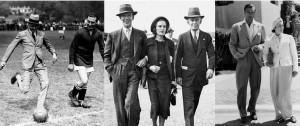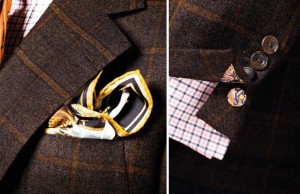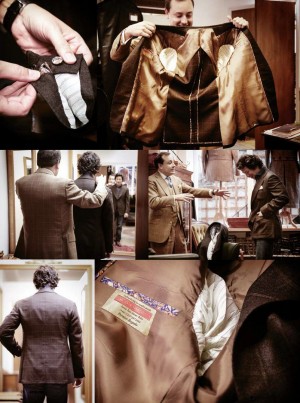Twice in 2 Months and I am Very Proud…..
……..To feature in this months Rake again, and this time I am keen to talk about a Jacket that I made for Wei Koh. I am so pleased with the result, and I could spend hours waxing lyrically about it, but as ever, it sounds better if it comes directly from the man who now owns the Jacket. I have reproduced the article below for your perusal.
KILLING THEM SOFTLY
the rake’s founder experiences the exalted craftsmanship of Steven Hitchcock — a Savile Row master whose command of the art of soft tailoring has taken the drape cut to dizzying new heights.
by wei koh
Amusingly, the war cry of the French Revolution — the one that had the great unwashed storming palaces and separating their more erudite counterparts from their heads — could also be the rallying cry for British soft tailoring.‘Liberty’, because soft tailoring means you are literally freed to enjoy the full range of human movement while still being immaculately dressed. During the most recent Merchant Taylors’ Ball inLondon, guest speaker AA Gill declared that all those present should pat themselves on the back: “Or if you’re in a Huntsman suit, get someone else to do it for you.” ‘Equality’,because there is a certain democratisation of the male form in soft tailoring, which makes men — whether fat or thin, short or tall — essentially have the same full-chested, long-shouldered,suavely sack-shaped, sporty silhouette. And ‘fraternity’, because it involves pledging yourself to the drape cut: there is no greater pleasure for its devotees than to detect the soft, diaphanous,vertical wrinkles across the chest and back of another man’s coat, and to bestow upon him their subtle nod of silent approval. The multiple factors leading the incendiary rise of the British drape came together in 1930, like tributaries gushing into one powerful river. To begin with, at the end of the Great War, men returned home to civilian life with a patent desire to reject the formality, rigidity and structure of the army. They wanted to embrace new beginnings and they wanted to be comfortable. So, they began to adapt codes previously reserved for sportswear to their street clothes. From the ’20s to the ’30s, we see a progressive loosening of clothing, and an Apparel Arts article from 1932 posted by Gentleman’s Gazette (www.gentlemansgazette.com) reads:“Trousers had been tight — they immediately widened. Waistlines had been emphasized — they immediately disappeared… With the disappearance of the last vestige of military influence from men’s clothing design, a loose ultra-civilian suit model came in.” Interestingly, at precisely the same time in 1930, a similar revolution was taking place in, of all places,Naples, where Gennaro Rubinacci and his tailor Vincenzo Attolini were creating the recipe for the Neapolitan jacket. This style of coat stripped out the majority of the structural elements — the horse hair, the heavy canvas — to arrive at a soft, flowing, chested coat that was declared to be ‘as light as the winds over Vesuvius’. But it is possible that both men, who were deeply connected with the prevailing themes in British tailoring, could also see the beginnings of the soft style emerge, and were inspired by this. But the greatest catalyst to the emergence and popularisation of soft tailoring was, of course, Edward VIII, the Duke of Windsor, who, with his tailor Frederick Scholte, created what was popularly called the ‘British drape’. Edward, commonly considered the world’s best-dressed man, lived in an age that coincided with the mass popularisation of photography, and so, he also became one of the most photographed men on earth, his image appearing in innumerable newspapers and glossies around the world. While the Apparel Arts article of 1932 suggested first convincing women of the British drape’s appeal, in order to win over potential male customers, it was probably the Duke of Windsor’s sophisticated, sporty sartorial élan that more profoundly compelled the world to revere this new silhouette. The other major influence throughout the ’40s and ’50s was the adoption of the soft style byHollywoodroyalty — in particular, the beautifully dressed Fred Astaire and Gary Cooper,
I am of the opinion that in the baste fitting, you can already tell whether the tailor has got it right or wrong. And if it is wrong, no amount oftweaking is going to make a significant difference.
both customers of Anderson & Sheppard, the tailoring house that became synonymous with this look. But look closely at the clothes worn by Astaire and you’ll see an incredible impeccability of fit. His shoulders, though long and unpadded, are the perfect width to bestow a suggestion of heroism. His chest, though full, is made with just the perfect amount of drape to build muscularity without descending into sloppiness. His waist is elegantly suppressed; his sleeves, though large at the area around the arm, scythe then narrow sleekly to his cuff. Despite the fact that soft tailoring does not hug the body in the way that military-inspired clothes do, you could make the argument that it is even more challenging, and necessitates even more precision, to create the perfect amount of drape. A soupçon of cloth too much across the chest and over the shoulder blades, and the jacket might descend into formlessness rather than sculpting the perfectly balanced soft silhouette. Fortunately for those looking for this level of perfection, Steven Hitchcock of Savile Row creates some of the very best soft-tailored clothes in the world. If the name sounds familiar, that’s because Steven is the son of John Hitchcock, the Managing Director and head cutter of the legendary Anderson & Sheppard. Steven embarked on his journey in 1990 and spent four years as an apprentice jacket-maker ,and then five years learning to cut and fit clothing under the tutelage of both his father and the legendary Norman Halsey. He has been running his own business for a decade-and-a-half, with 23 years in the tailoring industry. He first came to my attention when I ran into my friend James Dowling, who was wearing one of the nicest drape-cut tweed coats I’d ever seen, in a succulent ‘pinot noir’ colour no less. It was beautifully balanced, and had the lovely signature drape across the chest and back that reminded me of the iconic second-century- BC statue Winged Victory of Samothrace, found in the Louvre. In that work, marble comes to life with vibrant, diaphanous ripples of fabric expressing strength and energy, and Steven’s coat, similarly, seemed to literally vibrate with a sense of awareness of its environment, like a beautifully cut living organism.I was immediately intrigued. In my mind, an image began to form of a check coat. I saw a soft-tailored, drape sports jacket that tapped into the spirit of the ’70s, with huge, 4½-inch-wide, notched, high-gorge lapels to break up the volume of the chest drape. There would be a patch pocket to tease a bit of volume back in, and a single buttoning point — a sole axis on which on the carefully sculpted cloth pivoted — and a highly flared skirt, so that the energy created in the chest flowed through the waist and was regenerated again through the hips to create a prevailing sense of empowerment. The idea of the perfect drape-cut coat is an enormously appealing one, once you get around the concept of its very particular silhouette. Even one of my favorite tailors, Lorenzo Cifonelli, whose amazing lean-chested house-style exists in polar opposition to the British drape, once told me, “You know, I would actually like to try one drape coat just to see what it was like.” I had written in the past that I had reached an age where comfort had started to become a priority, and with that, I found myself inexorably guided to Steven Hitchcock’s doorstep. Entering his premises, I immediately connected with Hitchcock’s generosity with his time and energy. Says Hitchcock, “I don’t aspire to make a huge volume of clothing. I want to make sure that each and every coat is fitted and cut by me, so that every garment that leaves here is perfect.” We began with fabric selection, and arrived at a check Scabal fabric in a weight that was not naturally conducive to drape, because of its relative lightness. Rather than steer me aside, Steven seemed to genuinely revel in the challenge. Grinning, he remarked, “It’s true that heavier cloths like flannel drape the best, but I also love to make drape clothes in lightweight fabrics — even linen or cotton — because you have to be really precise with the fit.” While some other soft-tailoring houses believe that one single fitting is all they need before final delivery, Steven insists on both a baste fitting as well as a forward fitting before the final fitting. I am of the opinion that in the baste fitting, you can already tell whether the tailor has got it right or wrong. And if it is wrong, no amount of tweaking is going to make a significant difference. You can already, at the baste-fitting stage — where the cloth cut from your pattern is basted together in the most rudimentary way — also see the signature of the cutter: you can discern what his unique perspective on tailoring is and tell not only how well he has understood your physical form, but also how well he has been able to reach into your mind’s eye and comprehend what your
aspirations were. In every instance, Steven simply got it right. At every stage, he precisely understood what I wanted and transmitted these inchoate desires into form. He has a particular ability to almost read your thoughts and give them life through his manipulation of cloth that could be described as alchemic. “This is why it is so important that I work with every client that walks through my door,” he explains. “The thing is, when you go to other firms, you may not know the person who is measuring you or fitting you, or cutting your coat. It may be several different people that end up doing this, and there is no continuity of thought and expression from one person to the next. I oversee the total process of each garment, so I’m always thinking about what the client wants and can ensure that this is purposely communicated at every stage.” Throughout the process, Steven pushed himself to the extreme. Not content with a simple half-lined ‘buggy back’ coat, he sought out aLibertyprinted fabric to pipe the fabric edges and inserted a witty clin d’oeil, a Libertyprint-covered button that is meant to be worn unbuttoned and hidden. Each time I put the coat on, I was awed by its comfort, its lightness on the body. Even during fittings, I would forget I had it on, which, to me, is always the signifier of a perfectly fitted garment. I experienced a liberation that allowed me to commit physical acts, such as bending to tie my shoelaces or reaching to help pick up my photographer’s bag, that in more restrictive clothing would have been impossible. As the coat took shape over the weeks when I met Steven, I could tell it was a triumph, a magnificent representation of the true power of British drape to sculpt, energise and bring forth expressiveness, while maintaining the perfect harmony between comfort, rakishly dégagé spirit and beauty.






